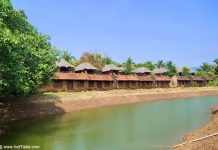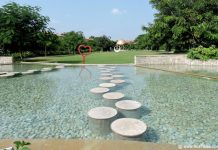I came to know about these Prehistoric rock art carvings at Pansoimol on a visit to the Goa State Museum. And had put it on my to-be-a-visited list. But it was an article in the newspaper with pictures of this rock art that made me get up and drive down to this rock by the river Sharawati and admire them firsthand.

It is a long drive from Panaji. A good 70+ km in the southeast direction. We were thankfully staying at Arco Iris a nice Goa Holiday Home. The drive was about 30 km from there. but since we were searching for this it took us almost an hour to reach the place. Till the village of Rivona and Colomb, we could follow a straight road.
Signage to Rock Art location
When a small hand-painted board on the right directed us to take a right turn. After this, we were on a road that was not kuchcha but it was not pucca either. After following some fallen ASI boards we reached a dead end. All we could see was a small rivulet and a thatched hut there. We got down and a man in a tomato-red T-shirt stepped out wearing a welcome smile. Almost like the one you expect from a castaway when he gets to see a human being after a long time. He was the ASI guard for the site and we crossed his office cum hut to reach the huge rock, where his own clothes were spread out to dry.
Prehistoric Rock Art Carvings at Pansoimol, Goa (Usgalimal)

Human Figurines
He enthusiastically started showing us the carvings, some of which were not very visible so he drew an outline with the water to make it stand out. He started with a set of three carvings that depict human birth. A sperm, a placenta, and a lady just after she has given birth. This can be easily linked to the pre-historic mother figure or the fertility cult. This was followed by a dancing figure balanced on one leg making me think if this could be the earliest version of Nataraja.
Animal & Bird carvings
There were numerous carvings of humped bulls and a few deer and one peacock that we could see. There were many types of hunting equipment and animal traps carved out. A pair of feet accompanied the most prominent figures. There is one place with three feet carved together. And another with two giant feet carved together. There are many figures that you cannot make out. A part of the rock has a lot of carvings that are confusing to an untrained eye.

Labyrinth
The most curious carving is a labyrinth about a meter or so in a radius that is so well carved that you wonder what could be the purpose of this carving. Among all the petroglyphs, this one stands out the most. Some reading on the Internet tells me that it is potentially the oldest known representation of a labyrinth. Similar carvings have been found around the world. Many of them have been found in India including some, on the temple carvings. But all of them probably are from a period later than this one.
ASI guide said many people from nearby villages come and offer milk on this labyrinth. And some of them even sit on top of it and meditate. The backdrop of the rock is the shallow Sharawati flowing on a bed of colorful pebbles and rich green tall trees. Providing a perfect contrast to the rusty tinge of the laterite stone.

Pansoimol Prehistoric carvings on laterite rock – A Goa Heritage
What makes this Goa Heritage even more unique is that such carvings exist in South India on granite stone and in central India on sandstone. But this is the only place where they have been found on the hard and iron-rich laterite stone. The deep engravings in precise formations also indicate the presence of appropriate sharp equipment to carve. I am not an archeologist. But to my knowledge, these are the only carvings that are not on walls but on a horizontal surface akin to having carvings on the floor. The site has existed in the open area for ages. And gets submerged in the waters of the river during monsoons.
Preserve the heritage
I am not sure if anything can be done to preserve this precious heritage. But the least that can be done is to have some brochures printed or boards displayed by Goa Tourism. So that visitors can make some head and tail of the carvings and know about them from authentic sources.

ASI discovery
I was told that Nand Kumar Kamat of ASI discovered this place in 1984. Discovery basically involved removing lots of mud and cleaning the rock. Apparently, a round of cleaning is done after every monsoon now. Archeologists believe these carvings can be anywhere from 8000 – 9000 years old belonging to the Mesolithic period. Technically the place is called Pansoimol or Usgalimol, but I did not find a board using any of these names.
It seems there are more such rocks in this area but there was no way for me to find out where. While driving back from the rock, I realized I might be driving on some of the petroglyphs. Some distance ahead there was a huge cut in the rock creating a kind of artificial lake that had emerald green water – looking beautiful, but probably a result of mining in the area.
While on Goa Holidays, if pre-history or rock-art interests you, this is a must-visit Goa Heritage.
Video of Rivona caves in South Goa hinterlands
Watch the video in HD mode for the best view. Take a look at the historical caves.
Rivona Caves in the village of Rivona in South Goa, 25 km southeast of Margao. These natural caves have been further carved by man to make them suitable for meditation. There is one large cave with a platform that was probably used by a preacher. On the side is a smaller, narrower cave that may have been used for deeper meditations, it was really dark and humid there. On the other side of the road is a second Rivona Cave which is smaller but better preserved. It is on the campus of Jeevottam Partagali Mutt.
This is a spiritual past of the sunshine state of Goa. Do visit it along with the Petroglyphs.













Have to visit on my next Goa visit.
You must Aadil. How are you? Seen you on IndiTales after a long time.
I couldn’t resist commenting. Very well written!
Thank you Kristen
Good information and i will visit in the next trip..
Great Sudhakar. Please do visit the ancient caves in Goa too.
I visited this place in 2001. I had just finished attending the first World Asian Vegetarian Congress and had left a few days in Mobir. My Lonely Planet guide showed a few dots on the local map. There was mention of Petroglyphs. I asked around about this place but no one had any clue.Taxi drivers knew nothing about the place. I persuaded one taxi driver to come with me on a search drive. We went through forests and asked locals on our way but no information. Then some one mentioned if Pandavas. We decided to explore that. We came to an old quarry. Behind that we saw a black stone beside a stream. There we saw these carvings on the black rock. A boy in torn shirt turned up. He started telling us about these carvings. When asked he said he employed by ASI.
Jayant, This is pretty much how we discovered these petroglyphs. They are lying in ignorance even today after so many years. There is a tiny ASI board but you have to know it exists to find it. The ASI employee stays there & I think is happy when someone comes there.
I am keen to know about the World Asian Vegetarian Congress.
Wonderful. Similar I had seen in bigfoot. Surely I will visit this place in my next visit to Goa.
Bigfoot has a big foot marked on a laterite stone. At Pansaimol, there is a whole range of carvings. You must see when you can.
Kushavati river, not Sharawati.
Anuradha, can we contact you for reuse of this article?
Sure, please write to us on the email mentioned on our contact page.